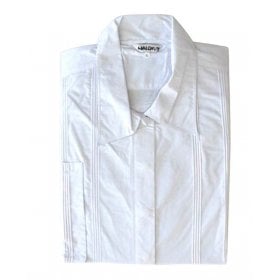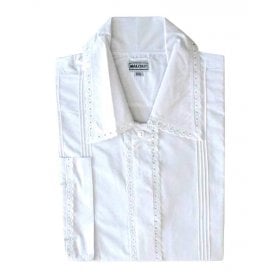Kittel
A kittel is a white robe worn in the synagogue on such major festivals as Rosh Hashana and Yom Kippur. The rabbi wears it, as does the cantor, the blower of the shofar, and male members of Ashkenazi congregations. Before a Seder dinner in traditional households, the leader of the Passover seder dons a kittel, and in Orthodox communities the bridegroom wears it at his wedding. Pious Jews use the kittel as a burial shroud.
-
 White Cotton Polyester Kittel Robe - Classic Design$57.65 - $65.81
White Cotton Polyester Kittel Robe - Classic Design$57.65 - $65.81 -
 White Cotton Polyester Kittel Robe - Lace Finish$49.38 - $63.12
White Cotton Polyester Kittel Robe - Lace Finish$49.38 - $63.12
WHAT IS A KITTEL?
A Kittel, also spelled kitl, comes from the Yiddish word for robe or coat. It is a snow white linen full length robe worn by married Ashkenazi men at major highlights in the Jewish calendar.
WHEN IS IT WORN?
It is worn on Yom Kippur when the white symbolizes that we hope we will emerge from this day fully cleansed from sin, as white as snow. There are those who also wear it on Rosh Hashonah.
On Pessach, the one who leads the Seder also wears a kittel. It is a sign of royalty and also a reminder of the High Priest who entered the Holy of Holies whilst wearing pure white garments. The one who leaders the Seder is like the High Priest.
Sometime the cantor wears it during special services of supplication such as first night of selichot, seventh day of Sukkot, musaf on Shemini Atzeret and first day of Passover when one prayers for rain and dew.
It is also worn by the bridegroom as he stands under the wedding canopy. This is a solemn moment. The sins of a groom are forgiven on his wedding day so the moments under the Chuppah are a form of Yom Kippur when a kittel is worn.
AJUDAICA’S KITTELS
We offer two beautiful well-tailored kittels sewn in Israel from cotton-polyester. One is a classical plain white. The other has the addition of lace around the collar and down the front. You will find on the site a detailed measuring chart. However, if you still find this difficult just call up our staff. They are thoroughly familiar with the measuring and they will be happy to help you.
GIFT
Traditionally, the bride sends the groom his kittel before the wedding day. There are no other specific traditions but it is a splendid gift for children to present to their father – especially if his old one is showing signs of wear. It is also important to have a spare kittel available in the synagogue, available for use when needed.
CONCLUSION
Our Sages relate that during the period of slavery in Egypt, the spiritual level of the Jews sank to an all-time low. There were however three areas in which the Jews maintained their superior identity, adamantly resisting blandishments to assimilate with the cultured and powerful Egyptians. The three areas are language, names and clothing. That is – they continued to speak Hebrew, they gave their new-born children tradition Jewish names and they did not follow Egyptian fashions but wore distinctive Jewish clothing. In this great merit, for which the Jewish People are eternally praised, they earned the merit of being saved from certain oblivion.
The kittel – an intensely Jewish garment – is a step in the direction of maintaining Jewish clothing and the values they represent.